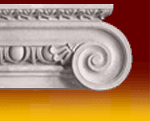|
|
Use a spreadsheet such as Excel to calculate the points in.
All of the formulas are listed within the screenshot. Click on the picture to enlarge it. The first column computes
the angle in degrees - this is where you can define the spacing between points. Copy and paste all four columns to create
as many points as you think you might need. You are only going to use a short segment of the curve - but it is fun to
watch the CAD program bring in the points.
The second column converts the degrees to radians. The
last two columns will be the X and Y Coordinates of each point.
|
|
|
Copy and paste the two columns with the X and Y coordinates
into a new sheet. Use the "paste special" command and select values only. Widen the columns so they
can display all the decimal places, and format the cells to show the numbers as a decimal instead of scientific notation.
Save the file as a CSV file (comma separated values). You will probably get some kind of warning, and the format
will only save the data on the open sheet. Now locate the file and open it with notepad. Be sure to select "all
files" so it will be in the list.
|
|
|
With the file open in notepad, delete the X and Y column headers.
Select all of the data and copy it to the clipboard.
|
|
|
In AutoCAD draw a polyline. When it asks for the coordinates
of the starting point, paste the data from the clipboard into the command line. If your points are very close together
it will take a few seconds to draw the curve. The curve will be centered around 0,0. Draw a 1-unit radius circle
centered at 0,0 to be used with the curve for checking the measurement of the curve. Mirror the curve and circle so
you can use it to draw the other side of the gear teeth.
|
|
|
Use a ratio of diameters to scale the involute curves to
the proper size for the gear you want to draw. For example, if the base circle diameter of your gear is 10 then 10 /
2 = 5 scale the curves and their circles by a factor of 5. Move one of the curves and it's circle by the center
to the center of your gear. The portion of the involute curve between the outside diameter and the base circle (or root) will
be the exact profile of the tooth. If the gear has fewer teeth and the base circle is larger than the root circle, the
the portion of the profile between the base and root circles will be a radial line segment. Repeat this with the mirror
image and rotate this curve around the center until it is the correct tooth thickness along the pitch line from the other
side of the profile. Copy the tooth with a polar array and trim away the unwanted segments.
|
|
|
Here the Excel computed polyline points are shown next to a profile
I drew with my old and now obsolete method. My Excel file computed points every 0.1° whereas the old method shown
here has 5° between points. I am not familiar with other drawing programs, I grew up using AutoCAD. I have
downloaded a free version of Google Sketchup, but haven't taken the time to learn how to use it yet.
|

